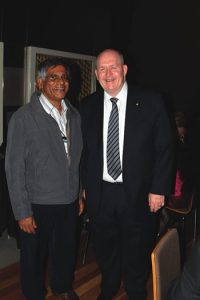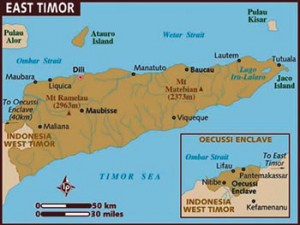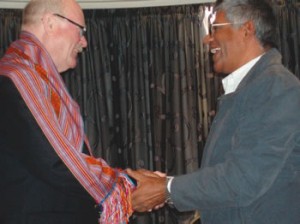The Reluctant Missionary
Fr Peter Puthenkandam’s path to the priesthood began as a primary schoolboy in his native India where it took two hours to walk there and back to Mass every Sunday with his mother “without fail” – a journey that eventually took him as a missionary priest to Timor Leste, a country so undeveloped you can’t even walk to most parishes, but need a four-wheel drive to reach them.
“Without four-wheel drive vehicles it’s impossible to reach village communities in any part of Timor Leste,” he says. “To get from Dili to the most southerly parish, Fohorem, in the dry season can take nine hours. In the rainy season it depends on a four-wheel drive – and luck. To get from the principal town of my diocese, Maliana, to the capital Dili, a distance of 120km, takes four hours.” Fr Puthenkandam cmf was brought to Australia in 2011 by the Australasian Catholic Press Association as its special guest at its 2011 annual conference in Adelaide. Caritas met the cost of the exercise.
One of the highlights of his visit was meeting the conference guest speaker, General Peter Cosgrove, who had led the international forces (INTERFET) in a peacekeeping mission when the United Nations intervened in East Timor in the 1990s. Fr Puthenkandam recalls the turmoil when the Indonesian administration withdrew from East Timor.
“Originally, when asked by my superior in 1991 to go to Timor, I was very reluctant to leave India,” he says. “But, of course, it was a matter of obedience.
“Now I have a deeper realisation of the truth: that He who called me to be a missionary, cares, plans and leads me at the cross roads and dead ends of my life. Of 20 years in Timor Leste; for example the care and hospitality I received from the catechists in the parish of Bobonaro from 1991-94 was a godsend. “
“But 1999 was something of personal crisis. During the mayhem after the referendum on August 30, together with my friend, a Christian Brother Dan Courtney, we organised ourselves and 23 of our Timor Leste friends, and crammed into two vehicles. We left Dili for Kupang, where we were sheltered with other refugees, among other places, in a seminary and in a convent of the RVM sisters in Penfui. Once the international peacekeepers and the Australian troops moved in, ships and flights were arranged for the refugees to return. Those we took to safety went back a month later. I had to get a fresh passport because mine had been destroyed in the fire which gutted our Catholic communications office. I eventually drove Br Dan’s car back from Kupang in November.
“1999 was a terrible time; 95 per cent of all houses and buildings, including Government offices and barracks, had been torched to ashes, after first being looted. Like almost all the houses and shops in Dili, our building was stripped of its fluorescent lights, switches, louvres, doors and window panes. Only the wall and the roof of the building remained.
“The effect of the violence and terror experienced by everyone in Timor Leste during that time, without doubt, has caused serious trauma for many for life. As for me, I have never witnessed such terror, and experienced such total helplessness in my life. I felt that only God could protect me and those who were with me.”
“So I’m deeply touched by the simple gestures and words of gratitude from those whom I brought to safety during the militias’ reign of terror in 1999, then came the providential re-establishing of the Catholic infrastructure of the diocese of Dili that had been burnt down by militias, and finally me ending up in the new diocese of Maliana when it was established in 2010.”
Maliana Diocese
In fiercely mountainous country, the diocese of Maliana encloses three East Timorese administrative districts – Liquisa, Bobonara and Kovalima – with a total population of about 225,000 people, 98 per cent of whom are Catholics, set up in 10 parishes. Dotted through the diocese are 10 pre-schools, 50 primary schools and 12 junior and senior high schools.
Teaching and caring for this community’s pastoral and spiritual needs are 13 diocesan clergy, 26 religious order priests – that’s about one priest for every 5000 people in the diocese – and about 85 religious women, coping with a wild and mountainous terrain without any sealed roads, except bitumen strips remaining from the time of Indonesia’s rule. And the ‘parishes’ are not exactly as they are known in Australia or New Zealand.
Nonetheless, in Maliana diocese there are 30 missionary stations where Masses are said every Sunday and 38 pastoral centres where Mass is celebrated once a month, subject to the weather and the stoutness of the four-wheel drives.
Fr Peter takes pride in statistics Australian parishes might envy: there are 40 seminarians in the diocese, half of whom are in their final years, 157 full-time catechists and just on 300 part-time catechists. As well there are four vocational training schools and there are also nine Catholic-run medical clinics.
Blessing in Disguise
He recalls his reluctance to leave India. “I did not want to come away from India where my roots were, to leave my country, my family and friends.
It was sad for me at the time. Now I confess that being asked to come to Timor Leste was a blessing in disguise. I have experienced God’s love and mercy and protection at various moments of my life there, and my nearly 20 years in being in Timor Leste has convinced me, deeply convinced me, that my vocation, my calling, are free gifts from God, not dependent upon my family or my own talents. It is unique, personal and the greatest expression of His love for me.”
The Claretians
The congregation, the Missionaries of the Immaculate Heart of Mary (CMF – Cordis Mariae Filii), isn’t in Australia or NZ, but worldwide there are 2142 CMF priests, 182 brothers and 535 professed students, present in 62 countries.
“We were founded by St Antony Mary Claret in Spain in 1849 and we also today have just on 120 novices, soon hopefully to be ordained.
“As a Claretian I was working in India in Andhra Pradesh when I was asked that time in 1992 to go to Timor Leste, one of the poorest countries in the world.
“The 2007 survey of Timor Leste living standards found that nearly 50 per cent of Timorese lived below the poverty line, estimated at 88 US cents per capita per day.
“In poverty the country is positioned at 120 out of 169 countries and at the 2004 census life expectancy was estimated at 59 years.
“This increased in the 2010 Census to a life expectancy of 62 years. The people live on agriculture, mostly corn and rice, also cassava and taro (a sweet potato), but the cultivation is mostly primitive. Drinking water is supplied by pipes connected to different creeks, but during summer, when many of the creeks run dry, you’ll see young girls carrying water in used five-litre cooking oil jerry cans, a common sight. Mind you, fresh vegetables are more than plenty; carrots, cabbage, beans and other vegetables grow plentifully in the tropical climate, with a variety of bananas throughout the year sold on ‘roadsides’ throughout the country.
“Rice and other essential commodities are imported mostly from Indonesia, Australia, Malaysia, China and Singapore.”
Fr Peter says the next, inevitable question is what sort of Aid are the people getting from Australia, both government and non-government?
“The sort of aid that our people get from Australia includes, of course, the Australian Army or the International Stabilisation Force, a United Nations police force, and then there are scholarships, financial help, consultancy services, training and capacity building, drinking water and sanitation projects, funding of academic and vocational training programs and income generation projects.”
But whether it’s the best or most appropriate, finds Fr Peter cautious.
“Very difficult to say.
“Obviously every help matters and makes a difference – make no mistake about that or about our gratitude – but I gather from others, so it’s said, that the Australian Government doesn’t go far beyond protecting its own interest while the Australian public stretches out their hearts and hands to the people of Timor Leste, very often certainly beyond their means.”
The Timor Sea Issue
And on the issue of the Timor Sea that separates Timor from Ausralia and the rich oil resources present in the Timor Gap, Fr Peter is blunt: “I‘ve heard many people, especially policymakers and others of influence, suggest that Australia is stealing the oil from the Gap, or at least the lion’s share of it.
“But ordinary people aren’t too aware of politics, either national or, even more so, international and the burden of nation building ought to be the task of those in power.
“Unfortunately there is widespread corruption in all aspects of life, at all levels of society as in other countries anywhere in the world: corruption not necessarily in monetary terms, but as favouritism, abuse of power or immunity from punishment – those sorts of transgressions.
“However, the Church is contributing to the building of this young nation by extending humanitarian assistance and relief supplies through its organisations like Caritas, and our clinics, convents and parishes. The Church has been providing its organisational capacity to manage community development projects in order to provide and sustain better services to the people. For example, Baucau diocese has started a teachers training college in collaboration with the Marist Brothers and Australian Catholic University, with long range plans to start a Catholic university in the country.
“And two years ago we built a maternity hospital.
“Meanwhile, we are engaged in permanent and structural collaboration between Church and State.”
Brian Davies is a Sydney based jounalist who does work for The Catholic Weekly. Reprinted with permission.
POSTSCRIPT: In 2012 Fr Peter Puthenkandam is still in East Timor where life is much quieter since the political scene has settled. He is the personal secretary of Bishop Norberto do Amaral, the bishop of the newest diocese, the third one in Timor Leste. He hopes to be there in Maliana for 18 more months.



 Entries(RSS)
Entries(RSS)